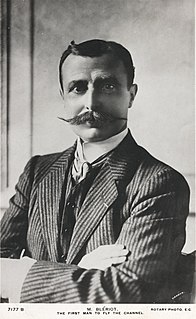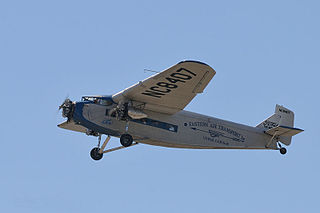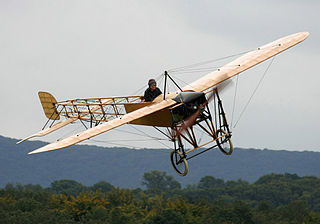Related Research Articles

Louis Charles Joseph Blériot was a French aviator, inventor, and engineer. He developed the first practical headlamp for cars and established a profitable business manufacturing them, using much of the money he made to finance his attempts to build a successful aircraft. Blériot was the first to use the combination of hand-operated joystick and foot-operated rudder control as used to the present day to operate the aircraft control surfaces. Blériot was also the first to make a working, powered, piloted monoplane. In 1909 he became world-famous for making the first airplane flight across the English Channel, winning the prize of £1,000 offered by the Daily Mail newspaper. He was the founder of Blériot Aéronautique, a successful aircraft manufacturing company.

The Ford Trimotor is an American three-engined transport aircraft. Production started in 1925 by the companies of Henry Ford and ended on June 7, 1933, after 199 had been made. It was designed for the civil aviation market, but also saw service with military units.

SPAD was a French aircraft manufacturer active between 1911 and 1921. Its SPAD S.XIII biplane was the most produced French fighter airplane of the First World War.

The Blériot XI is a French aircraft of the pioneer era of aviation. The first example was used by Louis Blériot to make the first flight across the English Channel in a heavier-than-air aircraft, on 25 July 1909. This is one of the most famous accomplishments of the pioneer era of aviation, and not only won Blériot a lasting place in history but also assured the future of his aircraft manufacturing business. The event caused a major reappraisal of the importance of aviation; the English newspaper The Daily Express led its story of the flight with the headline "Britain is no longer an Island".

The Blériot V was an early French aircraft built by Louis Blériot in 1907 and was his first monoplane. Although Blériot only achieved a couple of short flights in it, the second resulting in a crash which damaged the aircraft beyond repair, it was the first of his experimental aircraft to achieve any measure of success.

Blériot Aéronautique was a French aircraft manufacturer founded by Louis Blériot. It also made a few motorcycles between 1921 and 1922 and cyclecars during the 1920s.

The Blériot XII was an early French aeroplane built by Louis Blériot. It was first flown in May 1909 and was the first aircraft to be flown with two passengers on board, and was used by Blériot to gain second place in the 1909 Gordon Bennett Cup and to set a new world speed record.

The Goupy No.2 was an experimental aircraft designed by Ambroise Goupy and Mario Calderara and built in France in 1909 at the Blériot factory at Buc. The Goupy No.2 is significant for two major and influential innovations in aircraft design: it was the first tractor configuration biplane to fly and the first biplane to feature staggered wings, built with a landing gear configuration nearly identical in appearance to the Blériot XI monoplane, flown earlier that year. While both these features would very soon become the norm in aircraft design, the No.2 was described in the aviation press at the time as having a "somewhat unusual design". The only features that would not be typical of aircraft in the years to come would be its biplane tail unit, and the whole-chord wingtip ailerons fitted to both upper and lower wings. The uncovered wood box-girder fuselage, typical of early aircraft, was later covered.

From 1905 to 1915, Alessandro Anzani built a number of three-cylinder fan engines and radial engines, one of which powered Louis Blériot's 1909 cross-channel flight. An Anzani three-cylinder engine that powers a Blériot XI based in England is thought to be the oldest airworthy engine in the world.

The Stout Skycar was a series of four one-off American light aircraft of the 1930s.

The Nieuport IV was a French-built sporting, training and reconnaissance monoplane of the early 1910s.

Stout Metal Airplane Division of the Ford Motor Company was an American aircraft manufacturer founded by William Bushnell Stout as the Stout Metal Airplane Co. in 1922. The company was purchased by Ford Motor Company in 1924 and later produced the Ford Trimotor. At the height of the Great Depression, Ford closed the aircraft design and production division in 1936, temporarily re-entering the aviation market with the production of the B-24, at the Willow Run aircraft factory during World War II.

The Blériot XIII was an experimental passenger-carrying aircraft built during 1910 by Recherches Aéronautique Louis Blériot. It is notable for setting a record for passenger carrying flights, and was probably intended as a developmental aircraft for the Blériot XXIV Limousine.

The Nieuport II was a mid-wing monoplane racing or sport aircraft built by the Société Anonyme des Établissements Nieuport between 1910 and 1914 and was noted for its high performance using a small twin-cylinder engine, and winning many races, primarily in France before being used as a trainer during World War I by French flying schools.
The 1910 Hartman monoplane or Hartman original was the first aircraft built and flown in Iowa.

The Hubbard Monoplane, also nicknamed "Mike", was an early aircraft designed by John McCurdy and built by the Canadian Aerodrome Company.
The Airdrome Bleriot Model XI, also referred to as the Airdrome Bleriot XI, is an American amateur-built aircraft, designed and produced by Airdrome Aeroplanes, of Holden, Missouri. The aircraft is supplied as a kit for amateur construction.
Graham Gilmour was a British pioneer aviator, known for his impromptu public displays of flying. He was killed on 17 February 1912 when his Martin-Handasyde monoplane suffered a structural failure and crashed in the Old Deer Park in Richmond, London.

The pioneer era of aviation was the period of aviation history between the first successful powered flight, generally accepted to have been made by the Wright Brothers on 17 December 1903, and the outbreak of the First World War in August 1914.

The Blériot XXI was an early French aircraft built by Blériot Aéronautique.
References
- ↑ "The Saga of the Tin Goose: The Story of the Ford Tri-Motor".
- ↑ Ford Richardson Bryan. Beyond the Model T: The Other Ventures of Henry Ford. p. 163.
- 1 2 "Edsel Ford Speaks Out: Modest, capable, sincere, this young head of a great industry offers you some sound advice Schools for Industry An Eighty-Horsepower Ford All-Metal Planes EDSEL FORD SPEAKS OUT What of the Air-flivver?". The Youth's Companion: 306. June 1929.
- ↑ Robert F. Pauley. Michigan Aircraft Manufacturers. p. 12.
- ↑ Don Sherman (January 1997). "Why automobile cars do not fly". Air and Space.